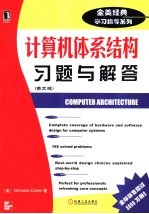

计算机体系结构习题与解答 英文版PDF电子书下载
- 电子书积分:12 积分如何计算积分?
- 作 者:(美)Nicholas Carter著
- 出 版 社:北京:机械工业出版社
- 出版年份:2002
- ISBN:7111104188
- 页数:306 页
CHAPTER 1 Introduction 1
1.1 Purpose of This Book 1
1.2 Background Assumed 1
1.3 Material Covered 1
1.4 Chapter Objectives 2
1.5 Technological Trends 2
1.6 Measuring Performance 3
1.7 Speedup 6
1.8 Amdahl's Law 6
1.9 Summary 7
Solved Problems 8
CHAPTER 2 Data Representations and Computer Arithmetic 16
2.1 Objectives 16
2.2 From Electrons to Bits 16
2.3 Binary Representation of Positive Integers 18
2.4 Arithmetic Operations on Positive Integers 19
2.5 Negative Integers 23
2.6 Floating-Point Numbers 28
2.7 Summary 35
Solved Problems 36
CHAPTER 3 Computer Organization 45
3.1 Objectives 45
3.2 Introduction 45
3.3 Programs 46
3.4 Operating Systems 50
3.5 Computer Organization 53
3.6 Summary 57
Solved Problems 57
4.1 Objectives 63
4.2 Introduction 63
CHAPTER 4 Programming Models 63
4.3 Types of Instructions 65
4.4 Stack-Based Architectures 70
4.5 General-Purpose Register Architectures 78
4.6 Comparing Stack-Based and General-Purpose Register Architectures 83
4.7 Using Stacks to Implement Procedure Calls 84
4.8 Summary 86
Solved Problems 87
CHAPTER 5 Processor Design 94
5.1 Objectives 94
5.2 Introduction 94
5.3 Instruction Set Architecture 95
5.4 Processor Microarchitecture 103
5.5 Summary 107
Solved Problems 108
6.2 Introduction 115
CHAPTER 6 Pipelining 115
6.1 Objectives 115
6.3 Pipelining 116
6.4 Instruction Hazards and Their Impact on Throughput 120
6.5 Predicting Execution Time in Pipelined Processors 126
6.6 Result Forwarding(Bypassing) 130
6.7 Summary 133
Solved Problems 134
CHAPTER 7 Instruction-Level Parallelism 144
7.1 Objectives 144
7.2 Introduction 144
7.3 What is Instruction-Level Parallelism? 146
7.4 Limitations of Instruction-Level Parallelism 147
7.5 Superscalar Processors 149
7.6 In-Order versus Out-of-Order Execution 149
7.7 Register Renaming 153
7.8 VLIW Processors 156
7.9 Compilation Techniques for Instruction-Level Parallelism 159
7.10 Summary 162
Solved Problems 164
CHAPTER 8 Memory Systems 175
8.1 Objectives 175
8.2 Introduction 175
8.3 Latency,Throughput,and Bandwidth 176
8.4 Memory Hierarchies 179
8.5 Memory Technologies 183
8.6 Summary 190
Solved Problems 191
CHAPTER 9 Caches 198
9.1 Objectives 198
9.2 Introduction 198
9.3 Data Caches,Instruction Caches,and Unified Caches 199
9.4 Describing Caches 200
9.5 Capacity 201
9.6 Line Length 201
9.7 Associativity 203
9.8 Replacement Policy 208
9.9 Write-Back versus Write-Through Caches 210
9.10 Cache Implementations 212
9.11 Tag Arrays 212
9.12 Hit/Miss Logic 214
9.13 Data Arrays 214
9.14 Categorizing Cache Misses 216
9.15 Multilevel Caches 217
9.16 Summary 219
Solved Problems 219
10.2 Introduction 229
10.1 Objectives 229
CHAPTER 10 Virtual Memory 229
10.3 Address Translation 230
10.4 Demand Paging versus Swapping 233
10.5 Page Tables 234
10.6 Translation Lookaside Buffers 239
10.7 Protection 243
10.8 Caches and Virtual Memory 245
10.9 Summary 247
Solved Problems 248
CHAPTER 11 I/O 255
11.1 Objectives 255
11.2 Introduction 255
11.3 I/O Buses 256
11.4 Interrupts 258
11.5 Memory-Mapped I/O 262
11.6 Direct Memory Access 264
11.7 I/O Devices 265
11.8 Disk Systems 266
11.9 Summary 270
Solved Problems 271
CHAPTER 12 Multiprocessors 279
12.1 Objectives 279
12.2 Introduction 279
12.3 Speedup and Performance 280
12.4 Multiprocessor Systems 282
12.5 Message-Passing Systems 285
12.6 Shared-Memory Systems 286
12.7 Comparing Message-Passing and Shared Memory 293
12.8 Summary 294
Solved Problems 295
INDEX 303
- 《管理信息系统习题集》郭晓军 2016
- 《大学计算机实验指导及习题解答》曹成志,宋长龙 2019
- 《联吡啶基钌光敏染料的结构与性能的理论研究》李明霞 2019
- 《异质性条件下技术创新最优市场结构研究 以中国高技术产业为例》千慧雄 2019
- 《卓有成效的管理者 中英文双语版》(美)彼得·德鲁克许是祥译;那国毅审校 2019
- 《21世纪法学系列教材 配套辅导用书 行政法与行政诉讼法练习题集 第5版》李元起主编 2018
- 《新编高中物理竞赛教程习题全解》钟小平主编;钟小平,倪国富,曹海奇编写 2019
- 《AutoCAD 2018自学视频教程 标准版 中文版》CAD/CAM/CAE技术联盟 2019
- 《跟孩子一起看图学英文》张紫颖著 2019
- 《柏里曼人体结构绘画教学描摹本 第2册 头手足结构》杨建飞主编 2019
- 《指向核心素养 北京十一学校名师教学设计 英语 七年级 上 配人教版》周志英总主编 2019
- 《北京生态环境保护》《北京环境保护丛书》编委会编著 2018
- 《高等教育双机械基础课程系列教材 高等学校教材 机械设计课程设计手册 第5版》吴宗泽,罗圣国,高志,李威 2018
- 《指向核心素养 北京十一学校名师教学设计 英语 九年级 上 配人教版》周志英总主编 2019
- 《高等院校旅游专业系列教材 旅游企业岗位培训系列教材 新编北京导游英语》杨昆,鄢莉,谭明华 2019
- 《中国十大出版家》王震,贺越明著 1991
- 《近代民营出版机构的英语函授教育 以“商务、中华、开明”函授学校为个案 1915年-1946年版》丁伟 2017
- 《新工业时代 世界级工业家张毓强和他的“新石头记”》秦朔 2019
- 《智能制造高技能人才培养规划丛书 ABB工业机器人虚拟仿真教程》(中国)工控帮教研组 2019
- 《AutoCAD机械设计实例精解 2019中文版》北京兆迪科技有限公司编著 2019
